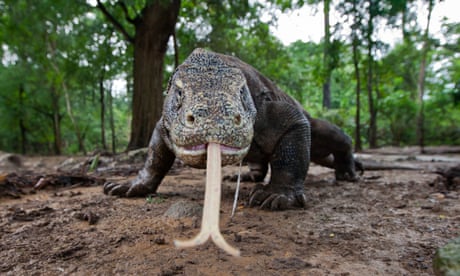
The following is from the Guardian
Authorities are considering banning tourists from Komodo, the island home of the ancient Komodo dragon, to allow for conservation efforts amid concerns over animal-smuggling.
The island, in Manggarai Barat, Indonesia, is a major tourist destination, with many making the trip to see the lizard which has a venomous bite, can grow up to three meters long and weigh more than 150kg.
Authorities are considering a temporary closure so they can plant native vegetation and help to restock the dragon’s food supply, thereby increasing the population, reported Tempo newspaper. Dates for the closure have not been confirmed but earlier discussions have suggested it could last a year.
The talks come amid efforts to tackle the illegal market in endangered species. Police in East Java arrested five people in March accused of smuggling Komodo dragons and other protected animals. Police said the suspects had already sold more than 41 Komodos through Facebook, supposedly for medicinal use. Tempo reported the lizards sold for 500m rupiah (£27,000) each.

Here be dragons: the million-year journey of the Komodo dragon
It is estimated there are about 5,700 Komodo dragons in the wild and the lizard is listed as both endangered and protected. They are found in the wild, primarily on the eastern Indonesian islands of Komodo, Padar, and Rinca.
Komodo is part of the Komodo national park, which also includes two other large land masses and many smaller islands. The rest of the park will remain open.
Discussions about closing the island have been going on since at least January, when the East Nusa Tenggara governor, Viktor Bungtilu Laiskodat, suggested the park may close for a year to increase the population of Komodo dragons and deer, which it eats. The governor said there were concerns that the lizard’s numbers had decreased due to declining prey and shrinking habitat.
The issue of how to manage sustainable tourism levels to the island has been fraught. In 2016, a major upgrade of Labuan Bajo regional airport, which serves the 29 islands that make up the Unesco-protected park, meant it went from being able to handle 150,000 tourists a year to 1.5 million.
Much is still being learned about the ancient lizard, which was only discovered by Europeans in the early 20th century. It was not until 2009 that scientists discovered Komodos have a very weak but venomous bite and kill their prey by infecting it and letting it bleed to death.
In 2013, two people were taken to hospital after being attacked by a giant Komodo dragon that wandered into the office of a wildlife park in eastern Indonesia.